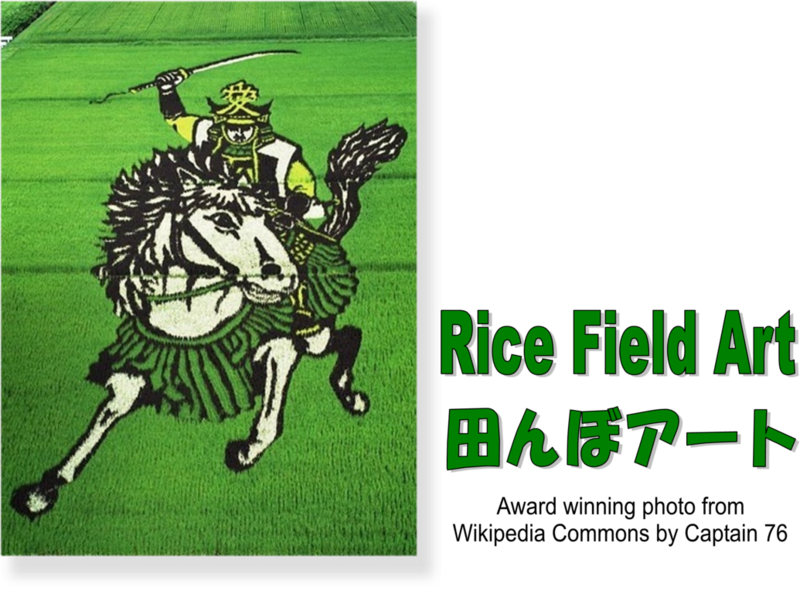Post by washi on Apr 26, 2015 18:51:51 GMT

July 27, 2013
A few days ago I happened to see a report about rice field art on a Japanese news broadcast. My jaw dropped at the vividness and detail of the images, and when I had time, I decided to see if I could locate the place in Google Earth.
In 1993 the village of Inakadate (田舎館村, Inakadate Mura) in Aomori Prefecture began creating pictures in rice fields adjacent to the Town Hall. This was done in honor of the archeological discovery that rice had been cultivated in the area for about 21 centuries. (This in itself is a bit surprising, since it is generally accepted that rice cultivation in Japan began in Kyushu and southwestern Honshu, and gradually spread eastward and northward, and the discovery of early cultivation at the northern tip of Honshu is a notable exception to this pattern.)
The designs are created by planting five different varieties of rice, which, as they ripen, produce contrasting colored leaves. In the early years, the designs were fairly simple, but over the years they have become increasingly complex. A viewing platform, externally resembling the keep of a Japanese castle, has been erected behind the Town Hall. Once the designs have been chosen, they are distorted for viewing from the tower, and then CAD software is used to lay out the planting patterns of the various strains of rice. The labor of well over a thousand people is required to carry out this work. All of the images created are well known and deeply resonant cultural icons, rendered in a crop so revered in Japan as to cross over from the realm of the mundane into the realm of the sacred.
The Wikipedia article and other searches show that similar projects have been undertaken in various areas. Recently (I'm guessing in 2012) a second site was developed at Yayoi no Sato (弥生の里), the site 2km east of the Inakadate town hall, where the ancient fields were discovered. There is a museum there, a Yayoi Period-themed playground, and other recreational facilities, as well as a view tower. Most of the other images are not nearly so sophisticated as the ones in Inakadate. I searched the paddies in Yonezawa, Yamagata Prefecture, to see if I could locate the rather nice one there that is pictured in Wikipedia, but had no luck in spotting it in the new (2012) but rather low resolution imagery. The vivid images are only visible for a few weeks between the time the plants fully ripen and the time they begin to turn brown, so even a very clear satellite image would have to be taken during a fairly narrow time window. I've found photos and videos of several other examples at other locations, but so far have been unable to find the specific sites.
As tambo art at the two sites I have located is not visible in the present Google Earth imagery, I have not placemarked them in the attached KMZ, but placemarks on them may be downloaded from it. I will add to this second file if other locations can be discovered.
April 27, 2015
[I posted the original file (a placemark on the Inakadate site, with a download available from it to placemarks on the second Inakadate site and the site in Yonezawa. When it was pointed out to me that CuriousJM had already made a VERY FINE POST on the location on February 20, 2010, I apologized to him, deleted my post, and provided access to the file through an internal link I made to it in the reply. With his blessing, I later removed the internal link and attached the file to the reply, so it would also appear in the GEC Layer. He has indicated to me that he will not be moving his post to the nGEC, so I am posting there independently.
I knew that there were many other Tanbo Art sites that I could not find in 2013. I found (with great difficulty, because I lack the sleuthing skills of the guys and gals over at Fun and Games) 10 new locations. This was at least partly the result of excellent Street View coverage and perhaps more Historical Imagery. I know there are some sites that I have not found. I only included those which I could see something either in the imagery or street view which convinced me I had found the site.
This file is ripe for continued updating, as each year more videos will certainly be published as new designs are planted and viewed, and updated imagery and street views will add (and perhaps subtract) relevant views. If and when I do, I will also simplify some of the complex tricks I have used to make this file suitable for viewing both as a download file and from the GEC Layer. (In a way, I will miss the challenge of inventing work-arounds, and would gladly go back if Craig and the boys will give us the Layer audience back.)
The visual information in this file is almost exclusively videos embedded from You Tube. They were used for two reasons: 1) even though the sound is not always pleasant, they mostly give a better feeling for being in the place than still pictures do, and 2) unless the poster specifies otherwise, permission to embed is already granted. I recently had some trouble playing embedded videos in Internet Explorer, and Noisette came to the rescue. I downloaded Foxfire - NPAPI from the Adobe download site, and Bob's your uncle, I was back in business.
I've gone to an unspeakable amount of trouble to update this file. It's not because I admire these images as art (although some do take my breath away). Many are infected by the national disease of Cuteness, which I can well do without. What I do so much admire is how they embody the cultural values of the society. If bread is so important to Western culture as to become a sacrament in the Christian religion, rice takes on a similar importance in Shintō, the national religion of Japan. The images, cute or stunningly realistic, all radiate images shared by the whole culture, although many of course also reflect local pride. What impresses me most about these images is the amount of planning and cooperative effort needed to bring them off. As an outsider living here and peering in, this strikes me as perhaps the greatest strength of the Japanese national character.
May 3, 2015
I last revised this file on April 30, 2015, in time to get it included in the GEC Layer. Now, free of the burden of writing for the Layer and dissatisfied with the ugly patchwork of different bits of historical imagery, I have tried another approach. One may, of course, expand the file and click from placemark to placemark in the usual way, without clicking on the links at the top of the introduction. This version allows the unnecessary step of flying each time to an elevation where the earth is whole and beautiful. Also unnecessary are the colored balloons, which in the Layer appear to have different content then when the complete file posted there is downloaded. I kept them here because, well, I think colored screens look nice. Except for number 1, the numbers on the menu are only there to help keep track of what has been seen.
 Download File
Download FileFile last revised May 3, 2015.

